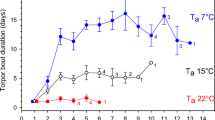Abstract
Many mammals hibernate each year for about 6 months in autumn and winter and reproduce during spring and summer when they are generally not in torpor. I tested the hypothesis that the marsupial pygmy-possum (Cercartetus nanus), an opportunistic nonseasonal hibernator with a capacity for substantial fattening, would continue to hibernate well beyond winter. I also quantified how long they were able to hibernate without access to food before their body fat stores were depleted. Pygmy-possums exhibited a prolonged hibernation season lasting on average for 310 days. The longest hibernation season in one individual lasted for 367 days. For much of this time, despite periodic arousals after torpor bouts of ∼12.5 days, energy expenditure was reduced to only ∼2.5% of that predicted for active individuals. These observations represent the first report on body-fat-fuelled hibernation of up to an entire year and provide new evidence that prolonged hibernation is not restricted to placental mammals living in the cold.


Similar content being viewed by others
References
Arendt T, Stieler J, Strijkstra AM, Hut RA, Rüdiger J, Van der Zee EA, Harkany T, Holzer M, Härtig W (2003) Reversible paired helical filament-like phosphorylation of tau is an adaptive process associated with neuronal plasticity in hibernating animals. J Neurosci 23:6972–6981
Arnold W (1993) Energetics of social hibernation. In: Carey C, Florant GL, Wunder BA, Horwitz B (eds) Life in the cold: ecological, physiological and molecular mechanisms. Westview, Boulder, CO, pp 65–80
Bladon RV, Dickman CR, Hume ID (2002) Effects of habitat fragmentation on the demography, movements and social organisation of the eastern pygmy-possum (Cercartetus nanus) in northern New South Wales. Wildl Res 29:105–116
Boyer BB, Barnes BM (1999) Molecular and metabolic aspects of mammalian hibernation. Bioscience 49:713–724
Buck CL, Barnes BM (2000) Effects of ambient temperature on metabolic rate, respiratory quotient, and torpor in an arctic hibernator. Am J Physiol 279:R255–R262
Carey HV, Andrews MT, Martin SL (2003) Mammalian hibernation: cellular and molecular responses to depressed metabolism and low temperature. Physiol Rev 83:1153–1181
Dausmann KH, Glos J, Ganzhorn JU, Heldmaier G (2005) Hibernation in the tropics: lessons from a primate. J Comp Physiol B 175:147–155
Degen AA, Kam M (1995) Scaling of field metabolic rate to basal metabolic rate in homeotherms. Ecoscience 2:48–54
Fisher KC, Manery JF (1967) Water and electrolyte metabolism in heterotherms. In:Fisher KC, Dawe AR, Lyman CP, Schönbaum E, South FE (eds) Mammalian hibernation III. Oliver and Boyd, Edinburgh, pp 235–279
French AR (1985) Allometries of the duration of torpid and euthermic intervals during mammalian hibernation: a test of the theory of metabolic control of the timing of changes in body temperature. J Comp Physiol B 156:13–19
Florant GL (1998) Lipid metabolism in hibernators: the importance of essential fatty acids. Am Zool 38:331–340
Geiser F (1993) Hibernation in the eastern pygmy possum, Cercartetus nanus (Marsupialia: Burramyidae). Aust J Zool 41:67–75
Geiser F (2004) Metabolic rate and body temperature reduction during hibernation and daily torpor. Annu Rev Physiol 66:239–274
Geiser F, Kenagy GJ (1988) Duration of torpor bouts in relation to temperature and energy metabolism in hibernating ground squirrels. Physiol Zool 61:442–449
Geiser F, Hiebert SM, Kenagy GJ (1990) Torpor bout duration during the hibernation season of two sciurid rodents: interrelations with temperature and metabolism. Physiol Zool 63:489–503
Körtner G, Geiser F (1995) Effect of photoperiod and ambient temperature on activity patterns and body weight cycles of mountain pygmy-possums, Burramys parvus (Marsupialia). J Zool (London) 235:311–322
Körtner G, Geiser F (1998) Ecology of natural hibernation in the marsupial mountain pygmy-possum (Burramys parvus). Oecologia 113:170–178
Körtner G, Geiser F (2000) The temporal organization of daily torpor and hibernation: circadian and circannual rhythms. Chronobiol Int 17:103–128
Millesi E, Prossinger H, Dittami JP, Fieder M (2001) Hibernation effects on memory in European ground squirrels. J Biol Rhythms 16:264–271
Nicol SC, Andersen NA (2007) Rewarming rates and thermogenesis in hibernating echidnas. Comp Biochem Physiol A Mol Integr Physiol (in press)
Schmidt-Nielsen K (1997) Animal physiology. Cambridge University Press, Cambridge, MA
Song X, Körtner G, Geiser F (1997) Thermal relations of metabolic rate reduction in a hibernating marsupial. Am J Physiol 273:R2097–R2104
Strahan R (1983) Pygmy possums and feathertail glider. In: Strahan R (ed) Complete book of Australian mammals. Angus and Robertson, Sydney, p 158
Thomas DW, Geiser F (1997) Periodic arousal in hibernating mammals: is evaporative water loss involved? Funct Ecol 11:585–591
Thomas DW, Dorais M, Bergeron J-M (1990) Winter energy budgets and cost of arousal for hibernating little brown bats, Myotis lucifugus. J Mammal 71:475–479
Turbill C, Körtner G, Geiser F (2003) Natural use of torpor by a small, tree-roosting bat during summer. Physiol Biochem Zool 76:868–876
Wang LCH (1978) Energetics and field aspects of mammalian torpor: the Richardson’s ground squirrel. In: Wang LCH, Hudson JW (eds) Strategies in cold. Academic, New York, pp 109–145
Willis JS (1982a) The mystery of periodic arousal. In: Lyman CP, Willis JS, Malan A, Wang LCH (eds) Hibernation and torpor in mammals and birds. Academic, New York, pp 92–103
Willis JS (1982b) Intermediary metabolism in hibernation. In: Lyman CP, Willis JS, Malan A, Wang LCH (eds) Hibernation and torpor in mammals and birds. Academic, New York, pp 124–139
Willis CKR, Brigham RM, Geiser F (2006) Deep, prolonged torpor by pregnant, free-ranging bats. Naturwissenschaften 93:80–83
Acknowledgements
I would like to thank Nereda Christian, Rebecca Drury, and Wendy Westman for technical assistance as well as Bronwyn McAllan, Gerhard Körtner, and Chris Pavey for constructive comments on the manuscript. The Australian Research Council supported this work. Permits were provided by the New South Wales National Parks and Wildlife Service and the University of New England Animal Ethics Committee.
Author information
Authors and Affiliations
Corresponding author
Rights and permissions
About this article
Cite this article
Geiser, F. Yearlong hibernation in a marsupial mammal. Naturwissenschaften 94, 941–944 (2007). https://doi.org/10.1007/s00114-007-0274-7
Received:
Revised:
Accepted:
Published:
Issue Date:
DOI: https://doi.org/10.1007/s00114-007-0274-7




